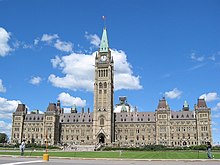Dominion Elections Act
| Dominion Elections Act | |
|---|---|
 | |
| Parliament of Canada | |
| |
| Citation | S.C. 1920 (10 & 11 Geo V), c. 46[1] |
| Enacted by | House of Commons of Canada |
| Enacted | June 29, 1920 |
| Enacted by | Senate of Canada |
| Assented to | July 1, 1920 |
| Legislative history | |
| First chamber: House of Commons of Canada | |
| Bill title | 12[2] |
| Introduced by | Hugh Guthrie |
| First reading | March 11, 1920[3] |
| Second reading | March 25-26, 1920[4] |
| Third reading | June 28, 1920[5] |
| Second chamber: Senate of Canada | |
| Bill title | 12 |
| Member(s) in charge | James Alexander Lougheed |
| First reading | June 29, 1920[6] |
| Second reading | N/A |
| Third reading | June 29, 1920[7] |
| Repeals | |
| Amended by | |
| Repealed by | |
| Dominion Elections Act, 1932[12] | |
| Related legislation | |
| Canada Elections Act | |
| Status: Repealed | |
The Dominion Elections Act[1] (French: Acte des élections fédérales)[13] was a bill passed by the House of Commons of Canada in 1920, under Robert Borden's Unionist government. The Act allowed white women to run for the Parliament of Canada. However, women from most/all minorities, for example, Aboriginals and Asians, were not granted these rights.[14] This bill was passed due in part to the advocacy of Nellie McClung, a women's rights activist from Manitoba.
The law established the agency now known as Elections Canada with the position of Chief Electoral Officer as head of the agency.[15]
Background
During World War I, the country was split on the issue of conscription. Ahead of the 1917 election, the Liberal Party experienced splits among individual MPs. Protests erupted over the government's plan to introduce conscription in what became known as the Conscription Crisis of 1917. Pro-conscription Liberals joined forces with the Conservative Party to form the Unionist Party in 1917, led by Prime Minister Robert Borden.
In an effort to increase votes for the new Unionist Party, Borden granted the vote to female relatives of active-duty soldiers. The 1917 election had the highest female voter turnout out of any other election, and the Unionist Party won a safe majority, with only Quebec voting majority Liberal.
See also
References
- ^ a b Dominion Elections Act, S.C. 1920, c. 46
- ^ Bill 12
- ^ March 11, 1920
- ^ March 25-26, 1920
- ^ June 28, 1920
- ^ June 29, 1920
- ^ June 29, 1920
- ^ SC 1921 (11 & 12 Geo V), c 29
- ^ SC 1925 (15 & 16 Geo V), c 42
- ^ SC 1929 (19 & 20 Geo V), c 40
- ^ SC 1930 (20 & 21 Geo V), c 16
- ^ Dominion Elections Act, S.C. 1934, c. 50
- ^ "Civilisations.ca - L'histoire du vote - Chronique : La période 1920-1997 à la loupe". www.museedelhistoire.ca. Musée canadien de l’histoire. Retrieved 20 January 2024.
- ^ "Chapter 3: Modernization, 1920–1981". A History of the Vote in Canada. Retrieved 25 January 2015.
- ^ "The Role and Structure of Elections Canada". Elections Canada. Retrieved 8 January 2017.